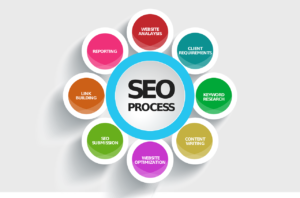Google 구글 SEO 마스터하기
오늘날의 디지털 시대에 강력한 온라인 입지를 확보하는 것은
블로그나 웹사이트의 성공에 매우 중요합니다.
검색 엔진 최적화(SEO)는 검색 엔진,
특히 가장 널리 사용되는 검색 엔진인 Google에서
콘텐츠를 검색할 수 있도록 하는 데 중요한 역할을 합니다.
노련한 블로거이든 막 여행을 시작하는 초보 블로거이든
효과적인 SEO 전략을 이해하고 구현하면
블로그의 가시성과 유기적 트래픽이 크게 증가합니다.
SEO 친화적인 블로그 게시물 작성의 핵심 구성 요소에 대해 5단계로 나누어 살펴보겠습니다.

I. 구글 SEO 마스터하기 – 키워드 조사
- 키워드 연구에 뛰어들기 전에 대상 대중을 명확하게 이해하는 것이 중요합니다. 그들의 관심사, 고충 및 선호도를 파악하여 그들과 공감하는 콘텐츠를 만드십시오.
- 키워드 조사 도구: Google Keyword Planner, SEMrush 또는 Ahrefs와 같은 다양한 키워드 조사 도구를 활용하여 블로그 게시물 주제와 관련된 관련성 높은 상위 키워드를 식별합니다.
- 롱테일 키워드: 롱테일 키워드는 더 구체적이고 덜 경쟁적이므로 순위를 매기는 것이 더 쉽습니다.
- 경쟁 분석: 일반적인 콘텐츠와 키워드를 분석하여 콘텐츠에 차별성을 둡니다.
II. 구글 SEO 마스터하기 – 페이지 최적화
- 제목 태그 및 메타 설명: 관심을 끌고 키워드가 풍부한 제목 태그와 메타 설명을 만들어 사용자가 검색 결과에서 블로그 게시물을 클릭하도록 유도합니다.
- URL 구조: 블로그 게시물의 URL이 간결하고 설명적이며 대상 키워드를 포함하는지 확인하십시오.
- 헤더 태그(H1, H2, H3): 헤더 태그를 사용하여 콘텐츠를 논리적으로 구조화하고 관련 키워드를 통합하여 Google이 콘텐츠의 계층 구조를 이해하는 데 도움을 줍니다.
- 키워드 배치: 블로그 게시물 전체에 자연스럽게 대상 키워드를 통합하되 키워드 채우기는 피하십시오.
- 이미지 최적화: 이미지에 대한 설명이 포함된 alt 태그를 사용하고 파일 크기를 줄여 더 빠르게 로드하고 이미지가 블로그 게시물의 관련성을 향상시키도록 합니다.
III. 구글 SEO 마스터하기 – 콘텐츠 품질
- 매력적이고 가치 있는 콘텐츠: 독자의 삶에 가치를 더하는 고품질의 유익하고 매력적인 콘텐츠를 만드세요. Google은 사용자 의도를 만족시키는 콘텐츠를 보상합니다.
- 포괄적인 콘텐츠: 청중이 가질 수 있는 잠재적인 질문이나 우려 사항을 해결하면서 주제를 심층적으로 다루는 블로그 게시물을 포괄적으로 만드십시오.
- 독창성 및 독창성: 다른 출처의 콘텐츠 복제를 피하십시오. 경쟁에서 눈에 띄는 독특한 관점과 통찰력을 제공하는 것을 목표로 합니다.
- 가독성 및 서식 지정: 콘텐츠를 더 짧은 단락으로 나누고 가독성을 높이기 위해 글머리 기호와 부제목을 사용합니다.
IV. 모바일 친화적, 페이지 속도 최적화
- 반응형 디자인: Google은 순위에서 모바일 친화적인 콘텐츠를 우선 순위로 지정하므로 블로그 게시물이 모바일 친화적이고 다양한 장치에서 올바르게 표시되는지 확인합니다.
- 페이지 속도: 이미지 압축, 브라우저 캐싱 활용, 콘텐츠 전송 네트워크(CDN) 사용을 통해 블로그 게시물의 로딩 속도를 최적화합니다.
- AMP(Accelerated Mobile Pages): 모바일 사용자 경험과 로드 시간을 향상시키기 위해 블로그 게시물에 AMP를 구현하는 것을 고려하십시오.
V. 링크 구축 및 프로모션
- 내부 링크: 블로그 게시물에 내부 링크를 통합하여 사용자를 웹 사이트의 관련 페이지로 안내하고 세션 시간을 늘립니다.
- 외부 링크: 콘텐츠에 신뢰성을 추가하는 평판이 좋은 출처에 대한 신뢰할 수 있고 관련성 있는 외부 링크를 포함합니다.
- 백링크 전략: 블로그의 권위와 순위에 긍정적인 영향을 미치는 평판이 좋은 웹사이트에서 고품질 백링크를 얻을 수 있는 백링크 전략을 개발하십시오.
결론적으로 Google SEO를 마스터하는 것은 경쟁이 치열한 온라인 환경에서
성공을 목표로 하는 모든 블로거에게 필수적입니다.
이 5단계에 설명된 전략을 구현하면
블로그의 가시성과 유기적 트래픽을 크게 향상시킬 수 있습니다.
철저한 키워드 조사를 수행하고,
페이지 안팎에서 콘텐츠를 최적화하고, 콘텐츠 품질을 우선시하고,
모바일 친화성과 페이지 속도를 통해 사용자 경험을 향상해야 합니다.
또한 강력한 내외부 연결 구조를 구축하여
블로그의 권위와 신뢰성을 높이는 데 중점을 둡니다.
SEO는 지속적인 프로세스이며 최신 트렌드와 알고리즘 변경 사항을 최신 상태로 유지하면
블로그가 검색 엔진 결과의 최전선에 유지됩니다.
헌신과 일관된 노력을 통해 여러분의 블로그는 귀중한 자원이 될 수 있으며
Google 검색 결과에서 순위를 올리는 동시에
구독자를 끌어들이고 참여시킬 수 있습니다.
행복한 블로깅 및 SEO 성공을 향한 첫걸음을 밟아보시기 바랍니다.
Mastering Google SEO: A Comprehensive Guide to Boost Your Blog’s Visibility
Introduction:
In today’s digital age, having a strong online presence is crucial for the success of any blog or website. Search Engine Optimization (SEO) plays a pivotal role in ensuring that your content is discoverable by search engines, especially Google, the most widely used search engine. This blog post aims to provide you with a comprehensive guide on how to write a blog post optimized for Google SEO. Whether you are a seasoned blogger or just starting your journey, understanding and implementing effective SEO strategies will significantly increase your blog’s visibility and organic traffic. Let’s delve into the key components of crafting an SEO-friendly blog post.
I. Keyword Research and Strategy
- Understand Your Audience: Before diving into keyword research, it’s essential to have a clear understanding of your target audience. Identify their interests, pain points, and preferences to create content that resonates with them.
- Keyword Research Tools: Utilize various keyword research tools like Google Keyword Planner, SEMrush, or Ahrefs to identify relevant and high-ranking keywords related to your blog post’s topic.
- Long-tail Keywords: Focus on long-tail keywords as they are more specific and less competitive, making it easier to rank for them.
- Competitive Analysis: Analyze your competitors’ content and keywords to gain insights into their strategies and identify content gaps.
II. On-Page Optimization
- Title Tag and Meta Description: Craft an attention-grabbing and keyword-rich title tag and meta description to entice users to click on your blog post in search results.
- URL Structure: Ensure your blog post’s URL is concise, descriptive, and includes your target keyword.
- Header Tags (H1, H2, H3): Use header tags to structure your content logically and incorporate relevant keywords to help Google understand your content’s hierarchy.
- Keyword Placement: Integrate your target keyword naturally throughout the blog post, but avoid keyword stuffing.
- Optimize Images: Use descriptive alt tags for images, reducing file size for faster loading, and ensuring images enhance your blog post’s relevance.
III. Content Quality and Relevance
- Engaging and Valuable Content: Create high-quality, informative, and engaging content that adds value to your readers’ lives. Google rewards content that satisfies user intent.
- Comprehensive Content: Make your blog post comprehensive, covering the topic in-depth while addressing potential questions or concerns your audience may have.
- Originality and Uniqueness: Avoid duplicating content from other sources; aim to offer unique perspectives and insights to stand out from the competition.
- Readability and Formatting: Break up your content into shorter paragraphs, use bullet points and subheadings for easier readability.
IV. Mobile-Friendly and Page Speed Optimization
- Responsive Design: Ensure your blog post is mobile-friendly and displays correctly on various devices, as Google prioritizes mobile-friendly content in its rankings.
- Page Speed: Optimize your blog post’s loading speed by compressing images, leveraging browser caching, and using content delivery networks (CDNs).
- AMP (Accelerated Mobile Pages): Consider implementing AMP for your blog posts to enhance mobile user experience and load times.
V. Link Building and Promotion
- Internal Links: Incorporate internal links within your blog post to direct users to relevant pages on your website and increase session duration.
- External Links: Include authoritative and relevant external links to reputable sources that add credibility to your content.
- Backlink Strategy: Develop a backlink strategy to earn high-quality backlinks from reputable websites, which positively impacts your blog’s authority and ranking.
In conclusion, mastering Google SEO is vital for every blogger aiming to succeed in the competitive online landscape. By implementing the strategies outlined in this comprehensive guide, you can significantly improve your blog’s visibility and organic traffic. Remember to conduct thorough keyword research, optimize your content on-page and off-page, prioritize content quality, and enhance user experience through mobile-friendliness and page speed. Additionally, focus on building a strong internal and external linking structure to enhance your blog’s authority and credibility. Keep in mind that SEO is an ongoing process, and staying up-to-date with the latest trends and algorithm changes will keep your blog at the forefront of search engine results. With dedication and consistent effort, your blog can become a valuable resource, attracting and engaging your target audience while climbing the ranks on Google’s search results. Happy blogging and SEO success!

